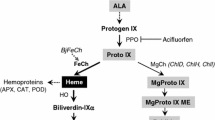Abstract
Protoporphyrin IX is a photosensitizer and a causative agent of rice membrane lipid peroxidation in plant cells. Protoporphyrinogen IX oxidase (PPO) is the molecular target of PPO-inhibiting herbicides, which trigger a massive increase in protoporphyrin IX. Thus, any possible method to decrease the levels of protoporphyrin IX upon challenge with PPO-inhibiting herbicides could be employed to generate plants resistant to such herbicides. We generated transgenic rice plants overexpressing rice ferrochelatase isogenes encoding ferrochelatase enzymes, which convert protoporphyrin IX into protoheme, to see whether the transgenic plants have phenotypes resistant to PPO-inhibiting herbicides. The resulting transgenic rice plants were all susceptible to oxyfluorfen (a diphenyl-ether-type PPO-inhibiting herbicide), as judged by cellular damage with respect to cellular leakage, chlorophyll loss, and lipid peroxidation. In particular, the transgenic plants expressing rice ferrochelatase II without its plastid targeting sequence showed higher transgene expression and oxyfluorfen susceptibility than lines expressing the intact ferrochelatase II. Possible susceptibility mechanisms to oxyfluorfen herbicide in the transgenic rice plants are discussed.






Similar content being viewed by others
Abbreviations
- FC:
-
Ferrochelatase
- PPO:
-
Protoporphyrinogen IX oxidase
References
Chow HS, Singh DP, Roper JM, Smith AG (1997) A single precursor protein for ferrochelatase-I from Arabidopsis is imported in vitro into both chloroplasts and mitochondria. J Biol Chem 272:27565–27571
Duke SO, Lydon J, Becerril JM, Sherman TD, Lehnen LP, Matsumoto H (1991) Protoporphyrinogen oxidase-inhibiting herbicides. Weed Sci 39:465–473
Emanuelsson O, Nielsen H, Brunak S, Heijne G (2000) Predicting subcellular localization of proteins based on their N-terminal amino acid sequence. J Mol Biol 300:1005–1016
Ha SB, Lee SB, Lee Y, Yang K, Lee N, Jang SM, Chung JS, Jung S, Kim YS, Wi SG, Back K (2004) The plastidic Arabidopsis protoporphyrinogen IX oxidase gene, with or without the transit sequence, confers resistance to the diphenyl ether herbicide in rice. Plant Cell Environ 27:79–88
Jung S, Lee Y, Yang K, Lee SB, Jang SM, Ha SB, Back K (2004) Dual targeting of Myxococcus xanthus protoporphyrinogen oxidase into chloroplasts and mitochondria and high level oxyfluorfen resistance. Plant Cell Environ 27:1436–1446
Jung S, Lee HJ, Lee Y, Kang K, Kim YS, Grimm B, Back K (2008) Toxic tetrapyrrole accumulation in protoporphyrinogen IX oxidase-overexpression transgenic rice plants. Plant Mol Biol 67:535–546
Lee HJ, Duke MV, Birk JH, Yamamoto M, Duke SO (1995) Biochemical and physiological effects of benzheterocycles and related compounds. J Agric Food Chem 43:2722–2727
Lee HJ, Lee SB, Chung JS, Han SU, Han O, Guh JO, Jeon JS, An G, Back K (2000) Transgenic rice plants expressing a Bacillus subtilis protoporphyrinogen oxidase gene are resistant to diphenyl ether herbicide oxyfluorfen. Plant Cell Physiol 41:743–749
Li X, Nicholl D (2005) Development of PPO inhibitor-resistant cultures and crops. Pest Manage Sci 61:277–285
Li X, Volrath SL, Nicholl DBG, Chilcott CE, Johnson MA, Ward ER, Law MD (2003) Development of protoporphyrinogen oxidase as an efficient selection marker for Agrobacterium tumefaciens-mediated transformation of maize. Plant Physiol 133:736–747
Lichtenthaler HK (1987) Chlorophylls and carotenoids: pigments of photosynthetic biomembranes. Methods Enzymol 148:350–382
Molina A, Volrath S, Guyer D, Maleck K, Ryals J, Ward E (1999) Inhibition of protoporphyrinogen oxidase expression in Arabidopsis causes a lesion-mimic phenotype that induces systemic acquired resistance. Plant J 17:667–678
Moulin M, Smith AG (2005) Regulation of tetrapyrrole biosynthesis in higher plants. Biochem Soc Trans 33:737–742
Papenbrock J, Pfündel E, Mock HP, Grimm B (2000) Decreased and increased expression of the subunit CHL 1 diminishes Mg chelatase activity and reduces chlorophyll synthesis in transgenic tobacco plants. Plant J 22:155–164
Papenbrock J, Mishra S, Mock HP, Kruse E, Schmidt EK, Petersmann A, Braun HP, Grimm B (2001) Impaired expression of the plastidic ferrochelatase by antisense RNA synthesis leads to a necrotic phenotype of transformed tobacco plants. Plant J 28:41–50
Acknowledgments
This work was supported by the Korea Research Foundation grant funded by the Korean Government (MOEHRD, Basic Research Promotion Fund, KRF-2007-313-F00006). We thank the National Institute of Agrobiological Sciences (http://www.rgrc.dna.affrc.go.jp/) for providing the rice ferrochelatase cDNAs.
Author information
Authors and Affiliations
Corresponding author
Additional information
Kiyoon Kang and Kyungjin Lee equally contributed to this article.
Rights and permissions
About this article
Cite this article
Kang, K., Lee, K., Park, S. et al. Overexpression of Rice Ferrochelatase I and II Leads to Increased Susceptibility to Oxyfluorfen Herbicide in Transgenic Rice. J. Plant Biol. 53, 291–296 (2010). https://doi.org/10.1007/s12374-010-9116-9
Received:
Revised:
Accepted:
Published:
Issue Date:
DOI: https://doi.org/10.1007/s12374-010-9116-9




